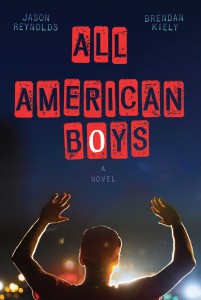 All American Boys by Jason Reynolds and Brendan Kiely (Atheneum, 2015) takes place over the span of one week – the week after a white police officer brutally beats an African American teen boy. It’s told in alternating points of view from the victim, Rashad, and from one of his white classmates, Quinn, who witnesses the beating.
All American Boys by Jason Reynolds and Brendan Kiely (Atheneum, 2015) takes place over the span of one week – the week after a white police officer brutally beats an African American teen boy. It’s told in alternating points of view from the victim, Rashad, and from one of his white classmates, Quinn, who witnesses the beating.
Rashad is an artist, a member of ROTC, and the son of a former police officer with strong expectations for Rashad’s future. It’s Friday night, and Rashad has a party and a girl on his mind. But first he has to shed his ROTC uniform and stop at the corner store for some chips. In the store, Rashad bends over to get something out of his duffle bag. A woman in the store trips over him, knocking them both to the ground. The store employee accuses Rashad of trying to steal the chips and a police officer springs into action, hauling Rashad out of the store, throwing him to the ground, and beating him. Rich in detail and well-developed characters, Rashad’s sections of the novel explore his recovery, the pressure he feels from his family and friends, his political awakening, and even his evolution as an artist, channeling his pain and anger into his art.
Quinn’s father was killed in Afghanistan. His mother works hard and he pitches in to help out with his younger brother. There are also expectations for his future, starting with impressing the basketball scouts and landing a college scholarship. But on that Friday night, he’s outside the store and witnesses the beating. Quinn doesn’t immediately recognize Rashad, but he does recognize the cop. It’s Paul, the older brother of Quinn’s best friend, a guy who stepped up for Quinn when his father died and even helped him hone the basketball skills that he’s hoping to parlay into a future. Quinn is forced to confront his own prejudices and assumptions while struggling against the pressure of his friends, coach, and family to either stay out of it or stand by Paul.
While some subplots could have been better developed and Quinn’s sections felt a little light on his interactions with the people in his life in the wake of the beating, the complimentary narratives provide readers with emotional insights and moments of empathy, while exploring the complex issues surrounding police brutality and racial injustice. Rashad’s sections are especially compelling, with a strong voice, organic characters, and an interesting emotional trajectory. Additionally, Quinn’s sections offer an important examination of privilege and what it means to be passive in the face of injustice.
All American Boys will resonate with teens already invested in social justice movements. But it will also spark discussion and critical thought for those teens who think police brutality or racial injustice only happens in other places to other kids.
Like with Kekla Magoon’s How It Went Down (reviewed in here in 2014), All American Boys is not only an engaging read, but it will foster discussion and self-examination of issues relevant to so many, if not all, adolescent readers.
1 comment for “Review: All American Boys by Jason Reynolds and Brendan Kiely”